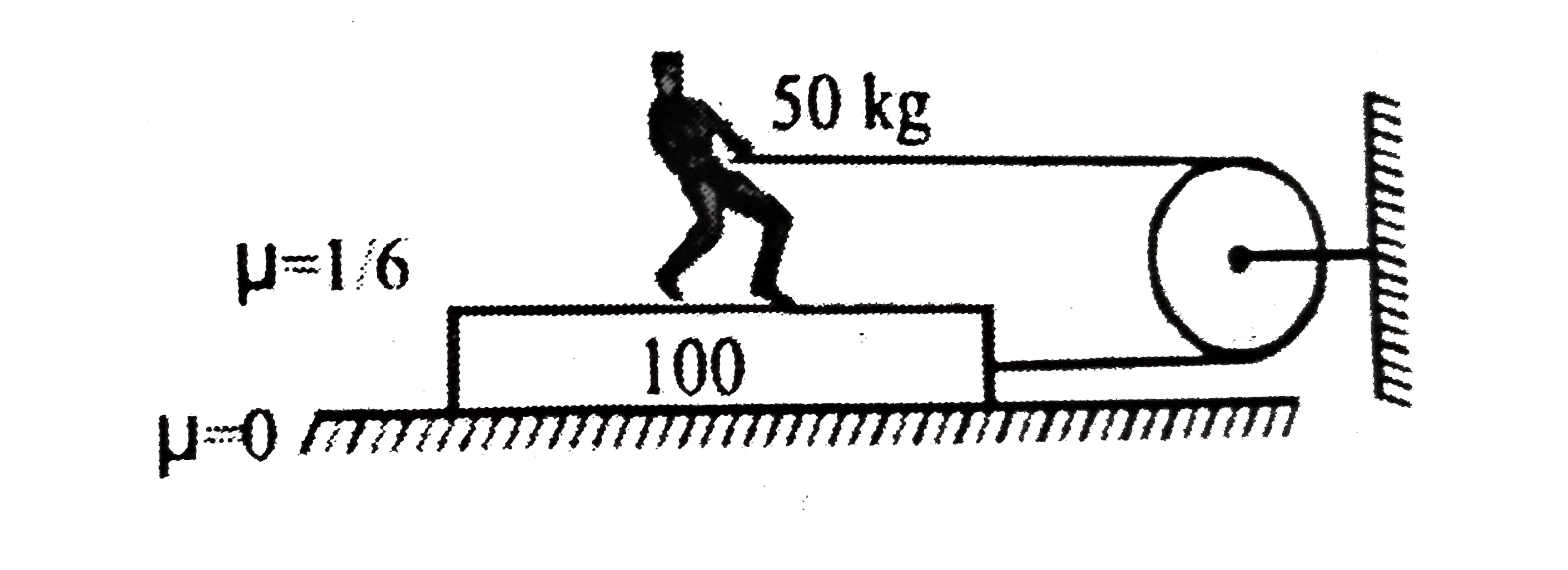AS 60 kg man pushes a 40 kg man by a force of 60 N. The 40 kg man has pushed the other man with a force of
40 N
0
60N
20 N
The correct Answer is:C, D
To solve the problem, we will use Newton's Third Law of Motion, which states that for every action, there is an equal and opposite reaction.
1. Identify the Forces Involved:
- A 60 kg man is pushing a 40 kg man with a force of 60 N.
2. Apply Newton's Third Law of Motion:
- According to Newton's Third Law, the force exerted by the 60 kg man on the 40 kg man (60 N) will have an equal and opposite reaction force exerted by the 40 kg man on the 60 kg man.
3. Determine the Reaction Force:
- Since the 60 kg man pushes the 40 kg man with a force of 60 N, the 40 kg man will push back with a force of 60 N in the opposite direction.
4. Conclusion:
- Therefore, the 40 kg man has pushed the 60 kg man with a force of 60 N.
Final Answer:
The 40 kg man has pushed the 60 kg man with a force of 60 N.
---
- A 60 kg man is pushing a 40 kg man with a force of 60 N.
- According to Newton's Third Law, the force exerted by the 60 kg man on the 40 kg man (60 N) will have an equal and opposite reaction force exerted by the 40 kg man on the 60 kg man.
- Since the 60 kg man pushes the 40 kg man with a force of 60 N, the 40 kg man will push back with a force of 60 N in the opposite direction.
- Therefore, the 40 kg man has pushed the 60 kg man with a force of 60 N.
The 40 kg man has pushed the 60 kg man with a force of 60 N.
Topper's Solved these Questions
- THE FORCESBOOK - HC VERMA ENGLISHCHAPTER - THE FORCESEXERCISE - Objective -2
7 Videos
- THE FORCESBOOK - HC VERMA ENGLISHCHAPTER - THE FORCESEXERCISE - Exercises
12 Videos
- THE FORCESBOOK - HC VERMA ENGLISHCHAPTER - THE FORCESEXERCISE - worked out Examples
3 Videos
- SPECIFIC HEAT CAPACITIES OF GASESBOOK - HC VERMA ENGLISHCHAPTER - SPECIFIC HEAT CAPACITIES OF GASESEXERCISE - All Questions
75 Videos
- WAVE MOTION AND WAVES ON A STRINGBOOK - HC VERMA ENGLISHCHAPTER - WAVE MOTION AND WAVES ON A STRINGEXERCISE - Question for short Answer
7 Videos
Similar Questions
A man of mass 50 kg is pulling on a plank of mass 100 kg kept on a smooth floor as shown with force of 100 N. If both man & plank move together, find force of friction acting on man.

View SolutionA uniform wooden plank of mass 150 kg and length 8 m is floating on still water with a man of 50 kg at one end of it . The man walks to the other end of the plank and stops. Than the distance covered by the plank is
View SolutionA 60 kg man runs up a staircase in 12 seconds while 50 kg man runs up the same staircase in 11, seconds, the ratio of the rate of doing their work is
View SolutionA man pushes a wall and fails to displace it.He does
View SolutionA man of mass 62 kg is standing on a stationary boat of mass 238 kg. The man is carrying a sphere of mass 0.5 kg in his hands. If the man throws the sphere horizontally with a velocity of 12 ms−1, find the velocity with which the boat will move (in magnitude)
View SolutionA 60kg is pushed horizontaly with just enough force to start it moving across a floor and the same force continues to act afterwards. The coefficient of static friction and sliding friction are 0.5and 0.4 respectively the accleration of the body is
View SolutionA man (mass =50kg) and his son (mass =20kg) are standing on a frictionless surface facing each other , the man pushes his son so that he start moving at a speed of 0.70ms−1 with respect to the man. The speed of the man with respect to the surface is:
View SolutionA 60 kg man skating with a speed of 10 m/s collides with a 40 kg skater at rest and they cling to each other. Find the loss of kinetic energy during the collision.
View SolutionA person of 60 Kg mass is in a lift which is coming down such that the man exerts a force of 150 N on the floor of the lift. Then the acceleration of the lift is (g=10 ms−2)
View SolutionTwo persons of masses 55kg and 65kg respectively are at the opposite ends of a boat. The length of the boat is 3.0m and weights 100kg. The 55kg man walks up to the 65kg man and sits with him. If the boat is in still water the centre of mass of the system shifts by.
View Solution
